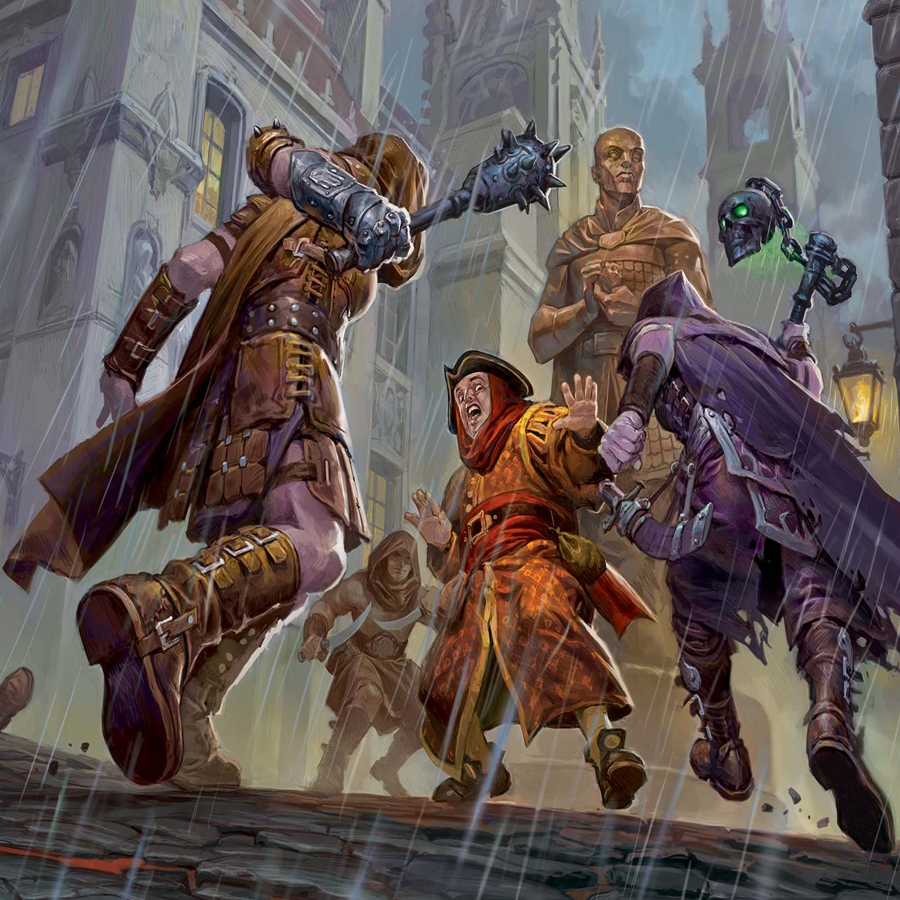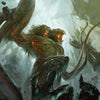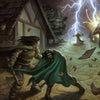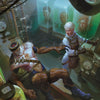The Problem with D&D Combat (and How to Fix It)

Written by Luke Hart
The fighter grips his sword in knuckle-whitened hands and charges into the room. He spies their hated foe, a terrible, wicked pit fiend, before him and rushes forward. The barbarian, slightly upset that he was first into the room, followed suit. The rogue skirts around the corners, remaining hidden and looking for that backstab. The cleric tentatively steps into the room, preparing healing spells that will most assuredly be needed, and the wizard stays out in the hallway, peeking around the door jam, knowing that the best way to not die is to stay out of that kill zone.
Thus, the combat begins, with characters rushing forward against their hated foe and players readying their dice and character sheets.
The fighter swings his sword and hits the pit fiend with all his might, and the barbarian swings his axe. The rogue stabs with her dagger. The pit fiend slashes and whips with all its fury, flames sprouting around it. The cleric calls down healing upon her friends. And the wizard nearly casts fireball but then goes with magic missile instead. And that was just the first round of combat.
In the next round, the fighter swings his sword, the barbarian swings his axe, the rogue stabs with her dagger, the pit fiend slashes and whips, the cleric heals, and the wizard doesn’t even think about fireball because he knows better and goes with magic missile instead. And that was the second round of combat.
Moving on to the third round of combat . . . I know you know exactly what’s coming next because we have all been in combats like this, haven’t we? Round after round after round, the characters do the exact same thing: swing with their swords, stab with their daggers, and cast mostly the same spells that they’re accustomed to casting every single combat because, hey, do what works, right?
Thus, the combat essentially comes down to chucking dice and doing math. And I submit to you that this is perhaps the worst sort of combat that we can have in D&D.
Watch or listen to this article by clicking the video below.
We can do a lot as game masters to improve combat. I’ve talked about tactics, environment, and many other things that spice things up. However, today, we’ll go over something that is perhaps under-addressed in the game. And that’s what characters can actually do on their turns. Let’s give players more options on their turns so they don’t always have to do the same thing on loop.
What exactly do I mean by this? Well, we know that the fighter can swing their sword, and the barbarian can hack with their axes, right? The rogue hides and then backstabs, and spellcasters, well, they cast spells. But what if there was something else you could do on your turns?
For instance, if you analyze the average D&D combat, characters don’t use their movement a whole lot. A lot of times, once you have settled into your position, you kind of stay put, period. Of course, this isn’t always true. Certain classes, such as rogues and spellcasters, to a certain degree, are behooved when they move around. But we often find that positioning is rather static for most of our turns. So, what would happen if you could do something else with your movement action?
In other words, you could hack with your sword, and then instead of not using your movement and just giving up that opportunity, you could use your movement action to do something else.
Another thing that is underused in the game, specifically in combat, is skills. Skills such as animal handling, deception, intimidation, investigation, perception, and survival get a lot of use out of combat, but they’re really underrepresented in combat. I know that you can shove somebody or trip them with your athletics, and rogues are gonna do a lot of sneaking with stealth, sure. But the options are very limited, and they don’t get used a whole lot.
So, my team and I have created a combat skill system. It allows you to use different skills from your character sheet in combat in meaningful ways. In our new combat skills system, every single skill from the character sheet is represented. That means no matter what class you’re playing, you will be able to do things with your skills in combat and have more options.
The immediate benefit of having more options during combat is that combat gets more interesting. You now have a whole new array of abilities open up your character. You can do more than just swing your sword or cast the same spells, and it’s not an either/or choice. You can swing your sword and use a combat skill. Or, you can cast your fireball and use a combat skill.
This adds complexity to the game because players can now choose from an array of different combat skills. In the game system, we call them tactical actions. Having more choices adds complexity, so it will probably result in slightly slower combat. Frankly, this is a trade-off that you make any time you introduce something new to the game. Using it reduces speed in exchange for increasing fun.
As I’ve said before, when you introduce added complexity to your game, you want to make sure the resulting fun is at least a three times increase. In other words, you want the added complexity to be worth it. A lot of times, the only way you’re going to know is to try it out. And when we were play-testing these new combat skill options, players really seemed to enjoy them.
How the Combat Skill System Works
OK, you’re probably saying, “That all sounds wonderful, but how does your stupid combat skill system work, Luke?” Well, first of all, it’s not stupid, so stop calling my stuff stupid. And I’m going to explain to you how it works right now, so just calm down. Or maybe I’m the one who needs to calm down. I don’t know. I can never tell.
The standard D&D turn consists of three types of actions a character can take. They have an action, a bonus action, and movement. And they get one of each. In our combat skill system, characters get an action, a bonus action, and a tactical action. So, the big change is that movement has been replaced by a tactical action. With their tactical action, a character can do one of two things: use their movement or use a tactic.
The tactics are the really cool things you can use based on your skills. They open up a wide array of possibilities in combat because they allow you to do new and different things to affect and change the course of battle. It intrinsically makes combat more interesting and fun because, instead of just standing around and swinging your weapons, you now have a ton of new options during your turns.
The tactics we made fall into one of six categories:
Attack Enhancements. These tactics give you a bonus to your next attack, and a few of them allow a character to follow up with a bonus action to get a bonus to all their attacks.
Attack Penalties. These tactics cause a targeted creature to suffer a penalty to their attacks against you.
Area Control. These tactics allow you to control a larger area than normal. Sometimes, this refers to direct control and area denial, but other times, it’s manipulating the terrain to make traversal more difficult.
Concealment. These tactics allow you to conceal your actions. They make it harder for creatures to discern what you’re doing, or you can modify an action with the intent of deceiving other creatures.
Information. These tactics allow you to gather or convey information. That information may include a battle strategy, the enemies’ strengths and weaknesses, or general information about the battle environment.
Movement. These combat tactics affect the way a creature moves around the battlefield. Unlike all the other tactic categories, this one always allows you to move up to your movement speed.
Now, the really cool thing about this system is that it creates a base upon which you can build your own combat tactics. I’m going to share several examples of the combat tactics we made in the system, but they don’t need to stop there. You can make your own, and the game master doesn’t have to be the only one creating the combat tactics. Players can pitch in with their creativity and ideas and help come up with more things to do with their skills during combat.
The Combat Tactics
Let’s go over some examples of specific combat tactics from our system.
The first one uses your Acrobatics skill called Prepare. You must be proficient in Acrobatics to use this, and its duration is instantaneous. Essentially, you anticipate an enemy’s attack and can dodge out of the way. You roll an Acrobatics check, and the result determines the bonus you receive. If you hit a DC 20, you get a + 1 bonus to the next Dexterity saving throw you make before the start of your next turn, and if you hit a DC 30, you get a + 2 bonus.
Then we have the Disguise a Spell tactic, which uses the Arcana skill. Essentially, you can attempt to disguise a spell you’re going to cast, befuddling attempts to identify it. You make an Intelligence (Arcana) check, and the DC required to identify a spell that you cast increases based on the result of the roll. If you hit a DC 20, the difficulty class to identify the spell has a +1 bonus, a DC 25 gets a + 2 bonus, and a DC 30 gets a + 3 bonus. Essentially, you’re trying to trick an enemy into thinking you’re casting a different spell. It does not alter the spell component requirements; it only makes it seem like the spell you’re casting is something else.
OK, here’s a really useful, if basic, one that melee types will probably love; it uses the Athletics skill. This tactic is called Strengthen Strike. Basically, you make an Athletics check, and then your next attack deals extra damage based on the result of your roll: A DC 20 gets you a + 1 to your damaged rolls, a DC 25 gets you a + 2, and a DC 30 gets you a + 3.
Then, we have the Determine Intent tactic, which uses your Insight skill. You see, we’re giving you useful ways to use some skills that almost never get used in the game—especially not in combat. This combat tactic allows you to attempt to discern a creature’s intent by observing the subtleties of its behavior. You make an Insight check, contested by the target’s Charisma saving throw.
On a success, you learn one of the following: the target of the creature’s next attack spell or other action it intends to use on its turn; whether the creature intends to make a melee attack range attack or cast a spell; its loyalty to its allies or whoever it’s working for; or its degree of personal hostility to you. For this tactic, the information you learn is random, but you may attempt to learn a specific piece of information by taking a -5 penalty to your check.
This next tactic is called Area Denial, and it uses your Intimidation skill. It allows you to attempt to control a larger area than normal, using your threats and stance to keep enemies away. This doesn’t expand the range of your attack or your attack of opportunity, but it does prevent enemy creatures from moving through the space. You then roll an intimidation check, and if you hit certain thresholds of difficulty classes, you control an additional 5-foot-square adjacent to the one you’re standing on.
Our combat system has 32 different tactical actions, so I’m not going to share all of them in this article.
But What about Monsters?
I imagine that my fellow dungeon masters out there have been asking themselves a particular question, “Do monsters get to do this too?” Because if players now get to do all these cool things, am I, as the game master, going to get to do them as well? The long and short of it is that, yes, monsters get to do it, too. Otherwise, we would have a rather unbalanced system, wouldn’t we?
The very next follow-up question, complaint, or concern I know my fellow dungeon masters will bring up is that monster skills in D&D 5th Edition generally suck. And you are 100% right. Many monsters don’t even have the skills on their stat block, or the skills are very limited. Frankly, this is kind of understandable because, in the base system, monsters don’t really have much use for many of their skills. However, if you’re implementing our combat skills system, monsters now suddenly have something to do with their skills. This could be pretty cool, fun, and exciting for dungeon masters, I imagine.
Well, the question then is, what can the game master do with these monsters with sucky skills? Of course, we address that in our system. Otherwise, having monsters use skill checks based on their ability scores with no modifiers would be, well, pathetic.
The basic rule of thumb is that you take a monster, identify its highest and second-highest ability scores, and then give that monster proficiency and perhaps even expertise in all skills associated with those ability scores. In fact, I would recommend taking its highest ability score and giving the monster expertise in all related skills. This means the monster would add double its proficiency bonus to those skills. Then, for its second-highest ability score, you give the monster basic proficiency with all related skills. Once you’ve done this, you’re pretty much good to go. Your monster will have various skills to use, and the modifiers to use those skills will be pretty darn good.
Now, something else I want to mention here is that giving your monsters additional abilities to use during combat will help solve one of the problems plaguing 5th Edition from its conception.
Essentially, what we have seen over the last decade is that players and their characters continue to get buffs and receive more options and power—but monsters have it. They’ve basically lagged behind on the power curve. For many groups, this is undesirable because it makes combat less challenging and unengaging. This means that if game masters want to correct for that, they need to tweak things in their games. Giving monsters the ability to use these combat tactics is one such tweak.
How to Keep Combat Moving
I’d like to expand on something I alluded to toward the beginning of the article, which is that introducing this system will add complexity and slow the game down a bit. I have a few pieces of advice for ways that game masters can keep combat moving along when using this new system.
My first tip is that when you’re preparing for the session and setting up the encounters, consider each creature’s role in the encounter, that is, your monsters. Some will be attackers, others will be defenders, and some will focus on support. Based on the creature’s role and which skills it can use best, make quick notes about which tactic it will most likely use and the second one it is most likely to use. That way, you have those notes on the stat block and can quickly choose from a couple of options during combat. You might even jot down two additional tactics as backups.
The last thing that you want to do when you’re in combat is flip through and choose from 32 different options for every monster. That will bog things down like crazy. You need to have a few optimal choices ready to go for each monster that you can quickly choose from. That will speed things up incredibly.
Now, as far as players go, I suggest strongly encouraging them to choose their combat tactic while everybody else is taking their turns. If they’re not ready to go on their turn, they should have a backup tactic. This is basically the combat tactic they will take if they struggle to choose what to do. For instance, if they’re a fighter, they might always use the Strengthened Strike tactic, which increases their damage.
This kind of goes without saying, but the more everyone is familiar with the different combat tactics and reads up on them before the game begins, the smoother the gameplay will be.
Tactical Combat Variant Plug
If you'd like to add expanded skill-based combat options for 5e characters to your game, pick up our Tactical Combat Variant ruleset. Use skills to sway the balance of battle and add more variety and excitement to the game!
This lightweight ruleset contains:
- Rules for making tactical use of skills in combat
- 33 new skill-based combat tactics such as disguise a spell, pocket sand, area denial, coordinate assault, and don't go into the light.
-
Posted in
Game Master How-To Articles







